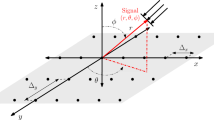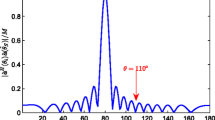Abstract
The classical least mean square (LMS) adaptive beamformer is one of the most widespread methods for producing a higher gain in the user direction and a lower gain in the directions of interferences. However, this method requires gradient estimation to update the complex antenna array weights. Thus, they do not use the previously available array samples for the required gradient estimation. Also, this method requires enormous iterations to minimize the error between the user signal and the desired signal. This aspect hinders the use of the classical LMS method in real-time systems where fast adaptive beamforming (ABF) and maximization of signal-to-interference (SIR) ratio are required. In this paper, the modified LMS beamformer is proposed which estimates the gradient by exploiting all the accessible samples. Furthermore, a double-crossed uniform linear array (ULA) called DCULA is presented. The proposed method is applied to this new configuration to enhance the interference rejection capability of the modified LMS ABF method.







Similar content being viewed by others
Data Availability
Not applicable.
References
Biswas, S., Xue, J., Khan, F. A., & Ratnarajah, T. (2018). Performance Analysis of correlated massive MIMO systems with spatially distributed users. IEEE Systems Journal, 12(2), 1850–1861.
Molisch, Ratnam, V., Han,S., Li, Z., Le, S. (2017) Hong Nguyen, L. Li, et al., "Hybrid Beamforming for Massive MIMO: A Survey", IEEE Communications Magazine
Kutty, S., & Sen, D. (2016). Beamforming for millimeter wave communications: An inclusive survey. IEEE Communications Surveys & Tutorials, 18(2), 949–973.
Bakhar, Md. (2020). Advances in smart antenna systems for wireless communication. Springer Wireless Personal Communications, 110(2), 931–957.
Shiqiang, C., & Zhang, H. Z. (2020). Research and experiment of radar signal support vector clustering sorting based on feature extraction and feature selection. IEEE Access, 8, 93322–93334.
Daniel, J. W. (1967). The conjugate gradient method for linear and nonlinear operator equations. SIAM Journal on Numerical Analysis, 4, 10–26.
Sarkar, T., Siarkiewicz, K. R., & Stratton, R. F. (1981). Survey of numerical methods for solutions of large systems of linear equations for electromagnetic field problems. IEEE Trans. Antennas Propagat., AP-29, 847–856.
Choi, S., & Sarkar, T. K. (1992). Adaptive antenna array utilizing the conjugate gradient method for multipath mobile communication. Signal Processing, 29, 319–333.
Choi, S., Kim, D. H. (1992) Adaptive antenna array utilizing the conjugate gradient method for compensation of multipath fading in a land mobile communication,” in Proc. IEEE 42nd Vehicular Technology Conf., Denver, CO, pp. 33–36.
Choi, S. (1991). Application of the conjugate gradient method for optimum array processing (Vol. V). Elsevier.
Winters, J. H., Salz, J., & Gitlin, R. D. (1994). The impact of antenna diversity on the capacity of wireless communication systems. IEEE Transactions on Communications, 42, 1740–1751.
Gebauer, T., & Gockler, H. G. (1995). Channel-individual adaptive beamforming for mobile satellite communications. IEEE J. Select. Areas Commun., 13, 439–448.
Diouris, J. F., Feuvrie, B., & Saillard, J. (1993). Adaptive multisensory receiver for mobile communications. Annals of Telecommunications, 48, 35–46.
Lindskog, E., (1995) “Making SMI-beamforming insensitive to the sampling timing for GSM signals,” in Proc. IEEE Int. Symp. Personal, Indoor and Mobile Radio Communications, Toronto, Canada, pp. 664–668.
Vaughan, R. G. (1988). On optimum combining at the mobile. IEEE Transactions on Vehicular Technology, 37, 181–188.
Shiqiang, C. Z., Dakulagi, V., & Zeng, H. (2020). Research and experiment of radar signal support vector clustering sorting based on feature extraction and feature selection. IEEE Access, 8, 93322–93334.
Passerini, C., Missiroli, M., Riva, G., & Frullone, M. (1996). Adaptive antenna arrays for reducing the delay spread in indoor radio channels. Electronics Letters, 32, 280–281.
Barrett, M., & Arnott, R. (1994). Adaptive antennas for mobile communications. Electron. Commun. Eng. J., 6, 203–214.
Ohgane, T., Matsuzawa, N., Shimura, T., Mizuno, M., & Sasaoka, H. (1993). BER performance of CMA adaptive array for high-speed GMSK mobile communication—A description of measurements in central Tokyo. IEEE Transactions on Vehicular Technology, 42, 484–490.
Alagirisamy, M. (2020). Adaptive beamformers for high-speed mobile communication. Wireless Personal Communications, 113, 1691–1707. https://doi.org/10.1007/s11277-020-07287-1
Ohgane, T., Shimura, T., Matsuzawa, N., & Sasaoka, H. (1993). An implementation of a CMA adaptive array for high speed GMSK transmission in mobile communications. IEEE Transactions on Vehicular Technology, 42, 282–288.
He, J. (2021). Improved direction-of-arrival estimation and its implementation for modified symmetric sensor array. IEEE Sensors Journal, 21(4), 5213–5220.
Chiba, I., Chujo, W., Fujise, M. (1993) “Beamspace constant modulus algorithm adaptive array antennas, in Proc. Inst. Elect. Eng. 8th Int. Conf. Antennas and Propagation, Edinburgh, Scotland, 1993, pp. 975–978
Jin, H., & Shu, T. (2022). A Planar-Like Sensor Array for Efficient Direction-of-Arrival Estimation. IEEE Sensors Letters, 6(9), 1–4.
Treichler, J. R., & Agee, B. G. (1983). A new approach to multipath correction of constant modulus signals. IEEE Trans. Acoust Speech, Signal Processing, ASSP-31, 459–472.
Jeripotula, P. R., (2019) Modified Leaky LMS Algorithm for Adaptive Beamforming, International Journal of Engineering, Applied and Management Sciences Paradigms (IJEAM), Volume 54 Issue 3 June.
Dakulagi, V. (2021). A new approach to achieve a trade-off between direction-of-arrival estimation and computational complexity. IEEE Communications Letters, 25(4), 1183–1186.
Jalal, B. (2022). A fast adaptive beamforming technique for efficient direction-of-arrival estimation". IEEE Sensors Journal, 22(23), 23109–23116.
Alagirisamy, M., & Mandeep, S. (2020). Efficient coherent direction-of- arrival estimation and realization using digital signal processor. IEEE Transactions on Antennas and Propagation, 68(9), 6675–6682.
Dakulagi, V. (2021). Single snapshot 2D-doa estimation in wireless location system. Springer Wireless Personal Communications, 117, 2327–2339.
Funding
Not Applicable to this work.
Author information
Authors and Affiliations
Corresponding author
Ethics declarations
Conflict of interest
The authors declare that they have no conflict of interest.
Additional information
Publisher's Note
Springer Nature remains neutral with regard to jurisdictional claims in published maps and institutional affiliations.
Rights and permissions
Springer Nature or its licensor (e.g. a society or other partner) holds exclusive rights to this article under a publishing agreement with the author(s) or other rightsholder(s); author self-archiving of the accepted manuscript version of this article is solely governed by the terms of such publishing agreement and applicable law.
About this article
Cite this article
Rekha, R.S., Parameshwara, M.C. & Dakulagi, V. Modified LMS Beamformer for Interference Rejection. Wireless Pers Commun 129, 2199–2211 (2023). https://doi.org/10.1007/s11277-023-10232-7
Accepted:
Published:
Issue Date:
DOI: https://doi.org/10.1007/s11277-023-10232-7




